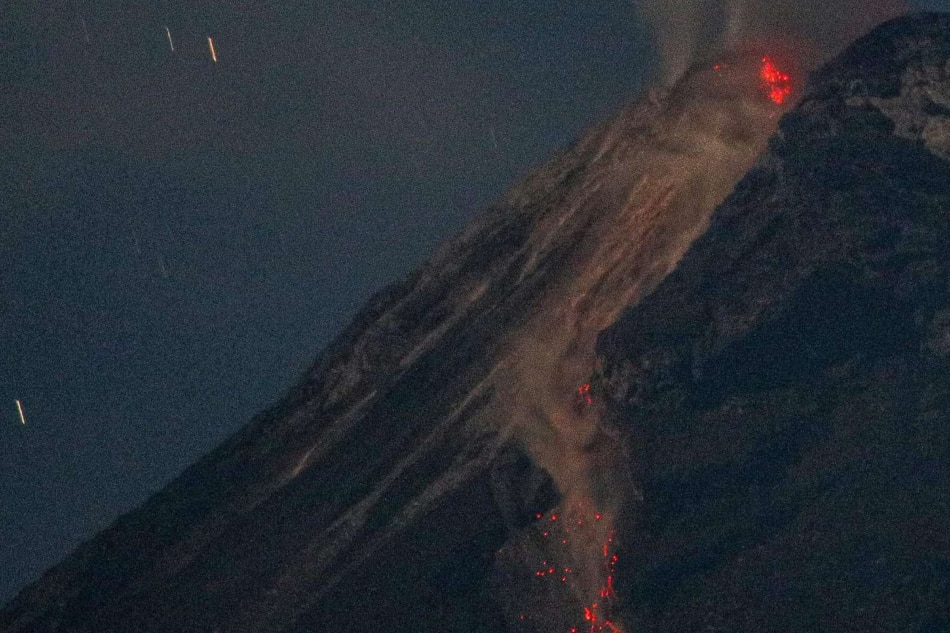Albay declares state of calamity due to Mayon Volcano's unrest | ABS-CBN
ADVERTISEMENT

Welcome, Kapamilya! We use cookies to improve your browsing experience. Continuing to use this site means you agree to our use of cookies. Tell me more!
Albay declares state of calamity due to Mayon Volcano's unrest
Albay declares state of calamity due to Mayon Volcano's unrest
ABS-CBN News
Published Jun 09, 2023 04:26 PM PHT
|
Updated Jun 09, 2023 05:43 PM PHT
MANILA (UPDATED) — The Albay provincial government on Friday declared a state of calamity a day after scientists raised the alarm over the active Mayon Volcano.
MANILA (UPDATED) — The Albay provincial government on Friday declared a state of calamity a day after scientists raised the alarm over the active Mayon Volcano.
The seismology agency said it observed 3 fast-moving avalanches of volcanic ash, rock and gases, known as pyroclastic density currents (PDCs), on Mayon's slopes on Thursday. It placed the volcano under Alert Level 3, which meant "increased tendency towards hazardous eruption."
The seismology agency said it observed 3 fast-moving avalanches of volcanic ash, rock and gases, known as pyroclastic density currents (PDCs), on Mayon's slopes on Thursday. It placed the volcano under Alert Level 3, which meant "increased tendency towards hazardous eruption."
Mayon's unrest has prompted the evacuation of thousands of residents around its 6-kilometer permanent danger zone and nearby areas, according to local officials.
Mayon's unrest has prompted the evacuation of thousands of residents around its 6-kilometer permanent danger zone and nearby areas, according to local officials.
There are around 4,749 families or 18,184 individuals living within the permanent danger zone, according to the Albay Public Safety and Emergency Management Office.
There are around 4,749 families or 18,184 individuals living within the permanent danger zone, according to the Albay Public Safety and Emergency Management Office.
ADVERTISEMENT
The state of calamity declaration will allow the provincial government to use the P30 million calamity fund to cater to the needs of evacuees, Albay Governor Edcel Greco Lagman said.
The state of calamity declaration will allow the provincial government to use the P30 million calamity fund to cater to the needs of evacuees, Albay Governor Edcel Greco Lagman said.
But the fund would only last for 15 to 20 days, Lagman said.
But the fund would only last for 15 to 20 days, Lagman said.
Five years ago, Mayon displaced tens of thousands of people after spewing millions of tonnes of ash, rocks and lava.
Five years ago, Mayon displaced tens of thousands of people after spewing millions of tonnes of ash, rocks and lava.
Phivolcs chief Teresito Bacolcol on Thursday warned that Mayon was ripe for another eruption, which usually happens once every 3 to 10 years.
Phivolcs chief Teresito Bacolcol on Thursday warned that Mayon was ripe for another eruption, which usually happens once every 3 to 10 years.
Mayon, a near-perfect cone located about 330 kilometers southeast of Manila, is considered one of the most volatile of the country's 24 active volcanoes.
Mayon, a near-perfect cone located about 330 kilometers southeast of Manila, is considered one of the most volatile of the country's 24 active volcanoes.
ADVERTISEMENT
Meanwhile, Taal volcano, located about 50 kilometers south of Manila, has been releasing sulphur dioxide this week, blanketing surrounding areas in smog and prompting warnings for people to stay indoors.
Meanwhile, Taal volcano, located about 50 kilometers south of Manila, has been releasing sulphur dioxide this week, blanketing surrounding areas in smog and prompting warnings for people to stay indoors.
Steam-rich plumes have been recorded rising two kilometers into the sky, the seismology agency said on Thursday. It has left the alert level at 1.
Steam-rich plumes have been recorded rising two kilometers into the sky, the seismology agency said on Thursday. It has left the alert level at 1.
Earthquakes and volcanic activity are not uncommon in the Philippines due to its position on the Pacific "Ring of Fire", where tectonic plates collide deep below the Earth's surface.
— With reports from Jose Carretero, ABS-CBN News; Agence France-Presse
Earthquakes and volcanic activity are not uncommon in the Philippines due to its position on the Pacific "Ring of Fire", where tectonic plates collide deep below the Earth's surface.
— With reports from Jose Carretero, ABS-CBN News; Agence France-Presse
ADVERTISEMENT
ADVERTISEMENT



